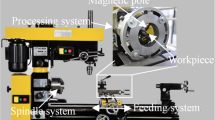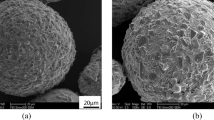Abstract
Magnetic abrasive finishing (MAF) is an effective surface refinement technology. However, its material removal mechanism remains elusive, stalling its advancement. This study utilized a spherical alumina magnetic abrasive powder (MAP) produced through atomization process to research on the grinding force of the MAF. A model was formulated to predict the grinding force in MAF, considering magnetic conductivity, MAP distribution, abrasive shape, and indentation depth. According to contact theory, the interaction between single abrasive and the workpiece is analyzed. A genetic algorithm was incorporated into the model to determine the unknown parameters of the normal grinding force. The friction coefficient between the alumina abrasives and the workpiece was deduced using the least squares technique. The model's predictions align with experimental data, providing deeper insights into the material removal behavior of the spherical alumina MAPs in MAF. The study delved into the material removal mechanism of the spherical MAPs in relation to surface characteristics. After using this MAP in the MAF process, surfaces exhibited micro-plowing.



















Similar content being viewed by others
References
Wan LL, Dai P, Li L, Deng ZH, Hu YH (2019) Investigation on ultra-precision lapping of A-plane and C-plane sapphires. Ceram Int 45(9):106–112
Rodaev VV, Zhigachev AO, Korenkov VV, Golovin YI (2018) Spherical engineering Ca-TZP ceramics made from baddeleyite: fabrication, structure and mechanical properties. Mater Sci Eng A 730:363–366
Wang LY, Sun YL, Chen FC, Zhang GG, Zhang P, Zuo DW (2022) Experimental study on vibration-assisted magnetic abrasive finishing for internal blind cavity by bias external rotating magnetic pole. Precis Eng 74:69–79
Ahmad S, Singari RM, Mishra RS (2021) Tri-objective constrained optimization of pulsating DC sourced magnetic abrasive finishing process parameters using artificial neural network and genetic algorithm. Mater Manuf Process 36(7):843–857
Yin SH, Shinmura T (2004) A comparative study: polishing characteristics and its mechanisms of three vibration modes in vibration-assisted magnetic abrasive polishing. J Mach Tools Manuf 44(4):383–390
Dhirendra K, Jain VK, Raghuram V (2006) Experimental investigation into force acting during a magnetic abrasive finishing process. Int J Adv Manuf Technol 30:652–662
Heng LD, Kim JS, Tu JF, Mun SD (2020) Fabrication of precision meso-scale diameter ZrO2 ceramic bars using new magnetic pole designs in ultra-precision magnetic abrasive finishing. Ceram Int 46(11):17335–17346
Yang B, Lu WZ, Feng W, Yang X, Zuo DW (2017) Adsorption and deposition of micro diamond particles in preparing diamond magnetic abrasives by ele-ctroless composite plating. Diam Relat Mater 73:137–142
Li WS, Li JJ, Cheng B, Zhang XJ, Song Q, Wang Y, Zhang T, Seniuts U, Belotsrkovsky M (2012) Achieving in-situ alloy-hardening core-shell structured carbonyl iron powders for magnetic abrasive finishing. Mater Des 212:110198
Heng LD, Tu JF, Im HC, Kim HJ, Chanchamnan S, Kin JS, Mun SD (2023) A novel auto-gaping magnetic pole system for inner surface finishing of non-circular pipes using magnetic abrasive finishing process. J Magn Magn Mater 580:170909
Azami A, Khoshanjam A, Jerez-Mesa R, Lluma-Fuentes J, Travieso-Rodriguez JA (2023) A new theoretical model for surface roughness prediction in rotational abrasive finishing process. Wear 524:204772
Wang AC, Lee SJ (2009) Study the characteristics of magnetic finishing with gel abrasive. J Mach Tools Manuf 49(14):1063–1069
Zou YH, Xie HJ, Zhang YL (2020) Study on surface quality improvement of the plane magnetic abrasive finishing process. Int J Adv Manuf Technol 109:1825–1839
Kala P, Pandey PM (2015) Comparison of finishing characteristics of two paramagnetic materials using double disc magnetic abrasive finishing. J Manuf Process 17:63–77
Xie HJ, Zou YH, Dong CW, Wu JZ (2019) Study on the magnetic abrasive finishing process using alternating magnetic field: investigation of mechanism and applied to aluminum alloy plate. Int J Adv Manuf Technol 102:1509–1520
Singh DK, Jain VK, Raghuram V (2004) Parametric study of magnetic abrasive finishing process. J Mater Process Techol 149:22–29
Misra A, Pandey PM, Dixit US (2017) Modeling of material removal in ultrasonic assisted magnetic abrasive finishing process. Int Mach Sci 131:853–867
Gao YW, Zhao YG, Zhang GX, Yin FS, Zhang HY (2020) Modeling of material removal in magnetic abrasive finishing process with spherical magnetic abrasive powder. Int Mech Sci 177:105601
Li C, Piao YC, Zhang FH, Zhang Y, Hu YX, Wang YF (2023) Understand anisotropy dependence of damage evolution and material removal during nanoscratch of MgF2 single crystals. Int J Extrem Manuf 5:015101
Wang JQ, Yan YD, Li C, Geng YQ (2023) Material removal mechanism and subsurface characteristics of silicon 3D nanomilling. Int J Mech Sci 242:108020
Li C, Hu YX, Zhang FH, Geng YQ, Meng BB (2023) Molecular dynamics simulation of laser assisted grinding of GaN crystals. Int J Mech Sci 239:107856
Zhang YB, Li CH, Ji HJ, Yang XH, Yang M, Jia DZ, Zhang XP, Li RZ, Wang J (2017) Analysis of grinding mechanics and improved predictive force model based on material-removal and plastic-stacking mechanisms. J Mach Tools Manuf 122:81–97
Li HN, Yu TB, Wang ZX, Zhu LD, Wang WS (2017) Detailed modeling of cutting forces in grinding process considering variable stages of grain-workpiece micro interactions. Int Mach Sci 126:319–339
Cheng J, Wu J, Gong YD, Wen XL, Wen Q (2017) Grinding forces in micro slot-grinding (MSG) of single crystal sapphire. J Mach Tools Manuf 112:7–20
Song Z, Zhao YG, Liu GX, Cao C, Gao YW, Zhang XJ, Li ZH, Pu YZ (2023) Study on finishing inner wall of CoCr alloy cardiovascular stent tube via novel atomized CBN/metal spherical magnetic abrasive powders. J Manuf Process 92:206–225
Sun JL, Qin F, Chen P, An T (2016) A predictive model of grinding force in silicon wafer self-rotating grinding. J Mach Tools Manuf 109:74–86
Shukla VC, Pandey PM, Dixit US, Roy A, Silberschmidt V (2017) Modeling of normal force and finishing torque considering shearing and ploughing effects in ultrasonic assisted magnetic abrasive finishing process with sintered magnetic abrasive powder. Wear 390:11–22
Kala P, Sharma V, Pandey PM (2017) Surface roughness modelling for double disk magnetic abrasive finishing process. J Manuf Process 25:37–48
Xu ZQ, Tang ZF, Chen F, Bo XQ, Wu H, Li ZX, Jiang SQ (2023) Study of lateral assembly of magnetic particles in magnetorheological fluids under magnetic fields. J Magn Magn Mater 566:170293
Funding
This work was supported by the Natural Science Foundation of Shandong Province (ZR2022QE157).
Author information
Authors and Affiliations
Contributions
Yuewu Gao: Conceptualization, Methodology, Investigation, Validation.
Pengfei Chen: Experiment, Writing original draft, Data.
Guiguan Zhang: Supervision, Resources, Review & Editing.
Zixuan Li: Supervision, Project administration, Funding acquisition, Resources.
Ruizhi Yan: Validation, Project administration.
Corresponding author
Ethics declarations
Ethics approval
Not applicable.
Consent to participate
Not applicable.
Consent for publication
Manuscript was approved by all authors for publication.
Competing interests
The authors declare no competing interests.
Additional information
Publisher's Note
Springer Nature remains neutral with regard to jurisdictional claims in published maps and institutional affiliations.
Rights and permissions
Springer Nature or its licensor (e.g. a society or other partner) holds exclusive rights to this article under a publishing agreement with the author(s) or other rightsholder(s); author self-archiving of the accepted manuscript version of this article is solely governed by the terms of such publishing agreement and applicable law.
About this article
Cite this article
Gao, Y., Chen, P., Zhang, G. et al. Research on grinding force modelling of spherical alumina magnetic abrasive powder. Int J Adv Manuf Technol 131, 1601–1614 (2024). https://doi.org/10.1007/s00170-024-13171-0
Received:
Accepted:
Published:
Issue Date:
DOI: https://doi.org/10.1007/s00170-024-13171-0




